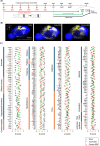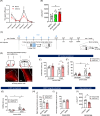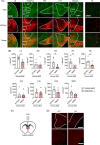The activation of the piriform cortex to lateral septum pathway during chronic social defeat stress is crucial for the induction of behavioral disturbance in mice
- PMID: 39638863
- PMCID: PMC11914691
- DOI: 10.1038/s41386-024-02034-7
The activation of the piriform cortex to lateral septum pathway during chronic social defeat stress is crucial for the induction of behavioral disturbance in mice
Abstract
Chronic stress induces neural dysfunctions and risks mental illnesses. Clinical and preclinical studies have established the roles of brain regions underlying emotional and cognitive functions in stress and depression. However, neural pathways to perceive sensory stimuli as stress to cause behavioral disturbance remain unknown. Using whole-brain imaging of Arc-dVenus neuronal response reporter mice and machine learning analysis, here we unbiasedly demonstrated different patterns of contribution of widely distributed brain regions to neural responses to acute and chronic social defeat stress (SDS). Among these brain regions, multiple sensory cortices, especially the piriform (olfactory) cortex, primarily contributed to classifying neural responses to chronic SDS. Indeed, SDS-induced activation of the piriform cortex was augmented with repetition of SDS, accompanied by impaired odor discrimination. Axonal tracing and chemogenetic manipulation showed that excitatory neurons in the piriform cortex directly project to the lateral septum and activate it in response to chronic SDS, thereby inducing behavioral disturbance. These results pave the way for identifying a spatially defined sequence of neural consequences of stress and the roles of sensory pathways in perceiving chronic stress in mental illness pathology.
© 2024. The Author(s).
Conflict of interest statement
Competing interests: The authors declare no competing interests.
Figures





References
-
- Lupien SJ, McEwen BS, Gunnar MR, Heim C. Effects of stress throughout the lifespan on the brain, behaviour and cognition. Nat Rev Neurosci. 2009;10:434–45. - PubMed
-
- Sanacora G, Yan Z, Popoli M. The stressed synapse 2.0: pathophysiological mechanisms in stress-related neuropsychiatric disorders. Nat Rev Neurosci. 2022;23:86–103. - PubMed
MeSH terms
Grants and funding
- JP21H04812/Ministry of Education, Culture, Sports, Science and Technology (MEXT)
- JP24K22086/Ministry of Education, Culture, Sports, Science and Technology (MEXT)
- JP22K06859/Ministry of Education, Culture, Sports, Science and Technology (MEXT)
- JPMJMS239F/MEXT | Japan Science and Technology Agency (JST)
- JP24zf0127010/Japan Agency for Medical Research and Development (AMED)
- JP24zf0127012/Japan Agency for Medical Research and Development (AMED)
- JP24wm0425001/Japan Agency for Medical Research and Development (AMED)
- JP21zf0127004/Japan Agency for Medical Research and Development (AMED)
- JP24wm0625117/Japan Agency for Medical Research and Development (AMED)
- JP24gm6310028/Japan Agency for Medical Research and Development (AMED)
- JP23KJ1550/MEXT | Japan Society for the Promotion of Science (JSPS)
- JP21J01369/MEXT | Japan Society for the Promotion of Science (JSPS)
- JP24K18224/MEXT | Japan Society for the Promotion of Science (JSPS)
LinkOut - more resources
Full Text Sources
Medical

